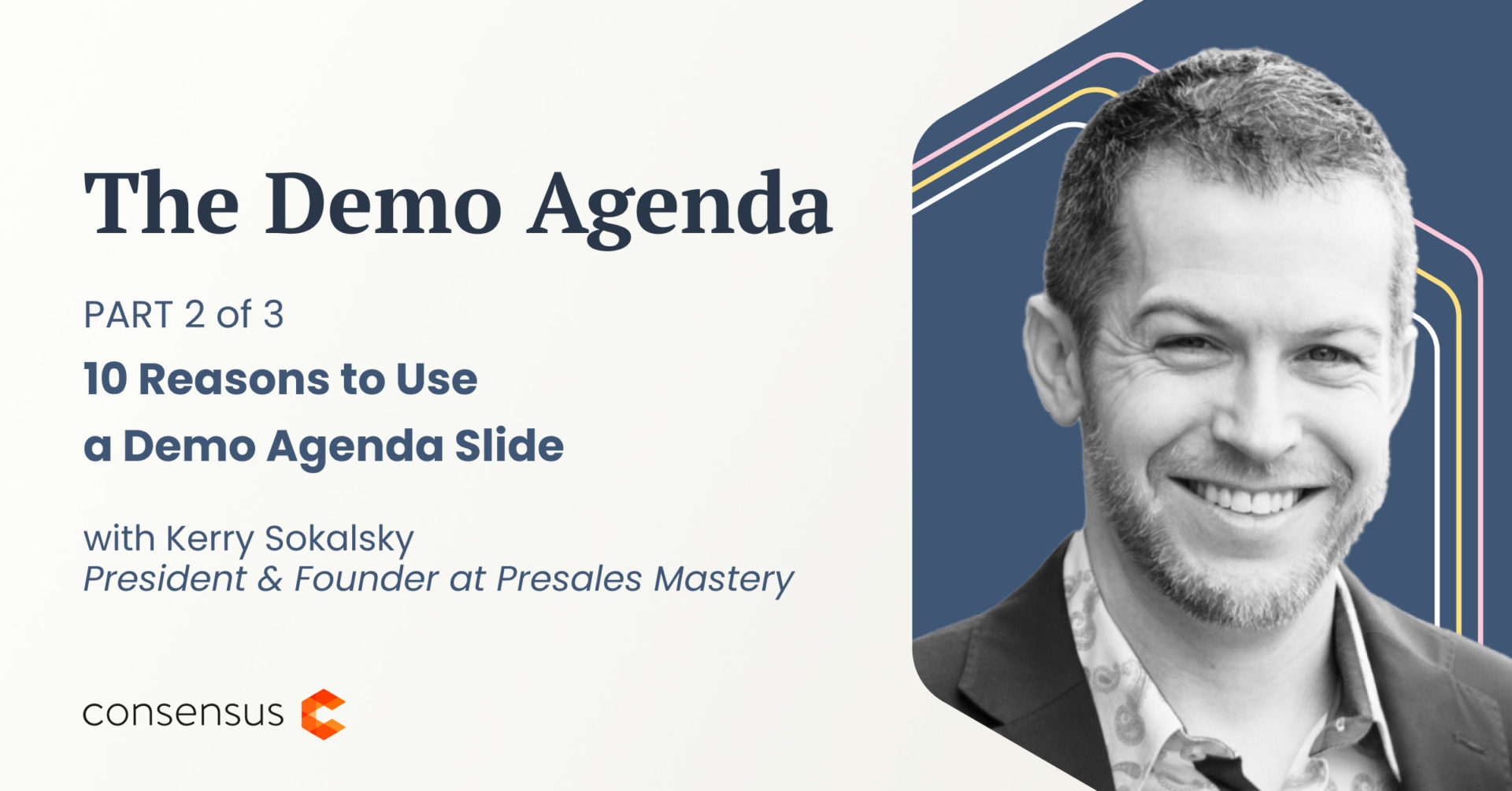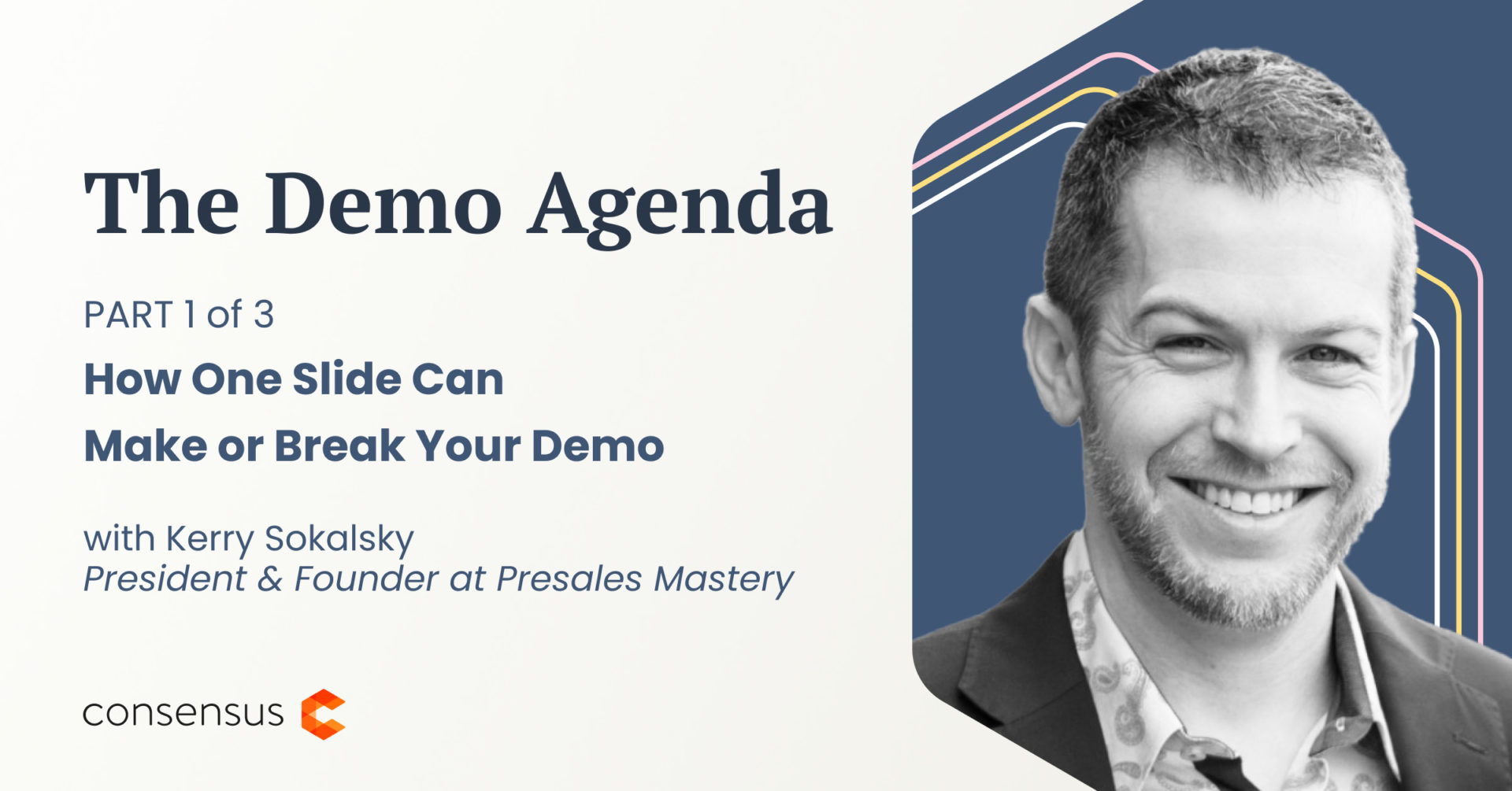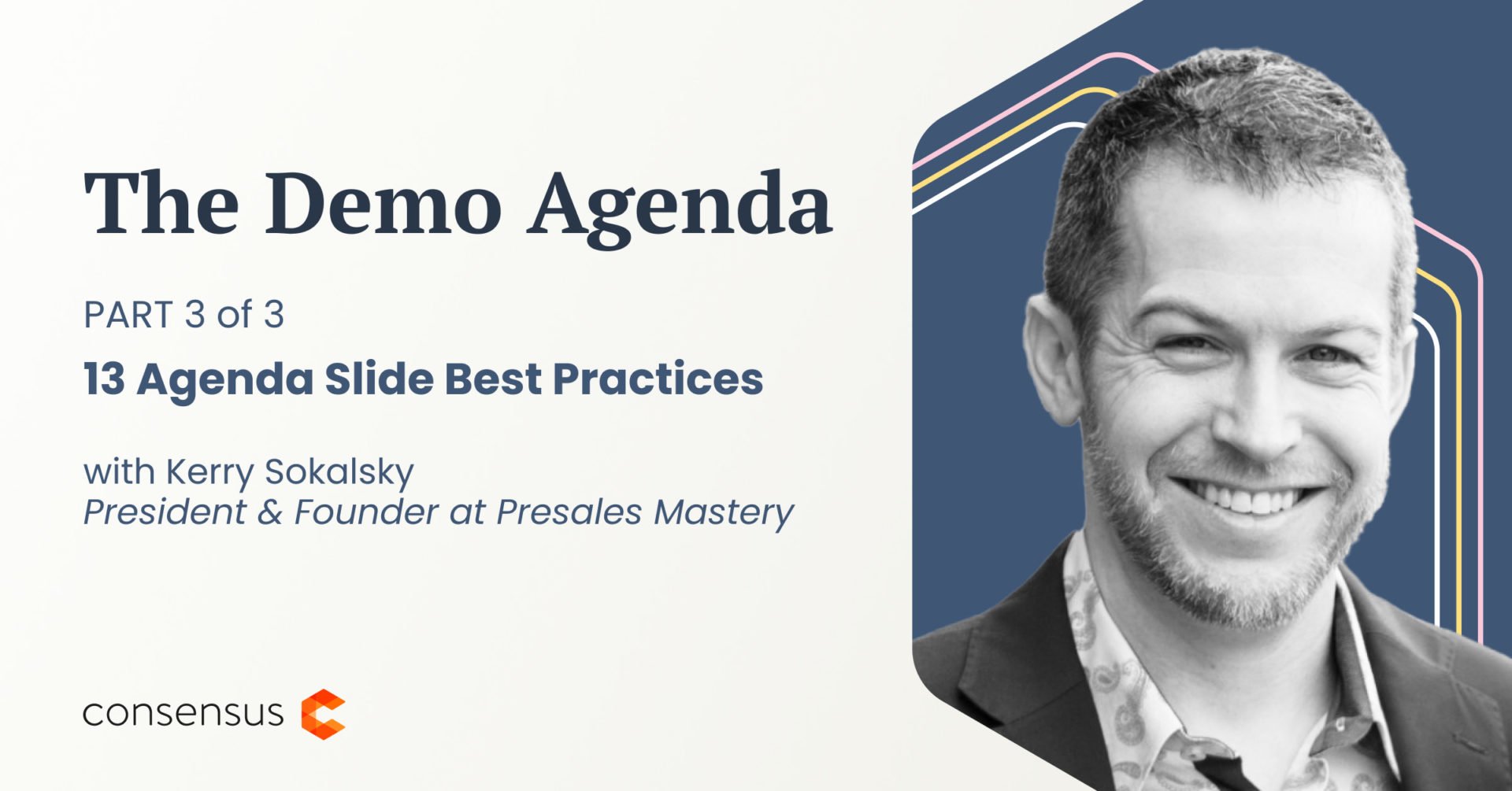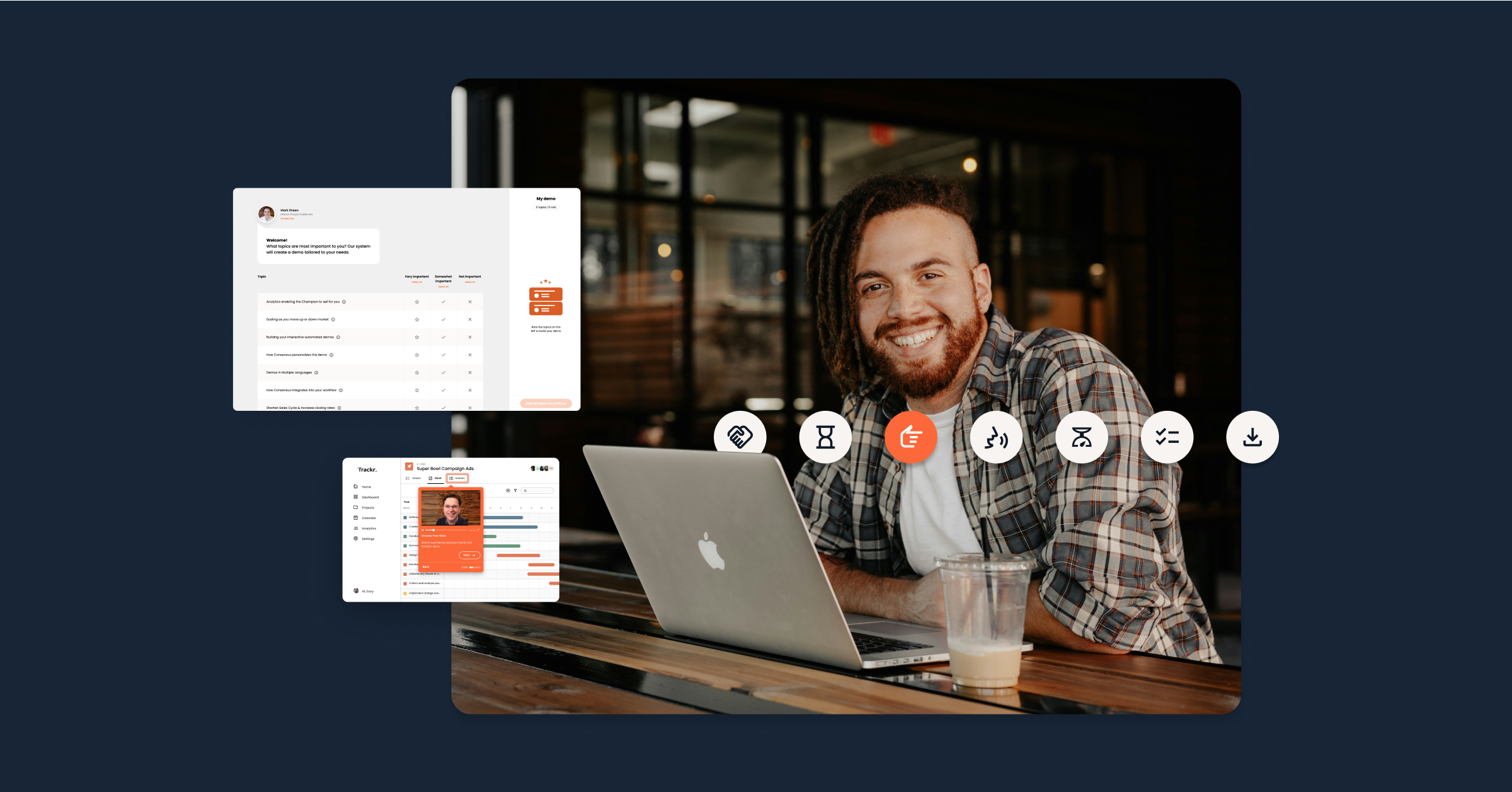Kerry Sokalsky is the Founder and President of Presales Mastery, helping B2B software sellers win ...
Close more deals with
Demo Automation.
Watch a Demo
At Presales Mastery, we coach sales engineers on how to deliver the best possible demos. One of the simplest, yet most effective ways to improve demo performance is to use a detailed demo agenda slide. I covered this in detail in my DEMOFEST 2022 session, The Demo Agenda: How One Slide Can Make or Break Your Demo, but here are the top 10 reasons to consider using a detailed demo agenda in your demos.
1. Clarify the Issues
Before we start coaching our clients’ demos, we always ask a few questions for context. One of those questions is pretty fundamental: “What are the prospect’s goals for the meeting?” Incredibly, the answer is all too often either they don’t know or just a generalized assumption. Whether you know ahead of time or not, agenda slides provide a great opportunity to clarify the prospect’s issues, objectives, and concerns. Having full transparency about the prospect’s situation ahead of time can ensure you’re better prepared to address their issues during the demo without making (potentially erroneous) assumptions.
Know before you go. Don’t wait until you’re in the middle of a demo to clarify that the topics you plan on covering apply to your audience. An agenda slide ensures there’s no surprises or missed topics before you start.
Things change. Even if you’ve done a thorough discovery call with the prospect, there’s no guarantee their situation is the same when the demo rolls around. Use the agenda slide as an opportunity to verify if anything has changed.
Expanded audiences. Demo audiences tend to include more and different individuals than pre-demo discovery sessions. Because of that, information learned in discovery may only reflect the opinions and needs of a subset of all the target stakeholders. Use the demo agenda as an excuse to ask everyone in the audience to take a few seconds to share their top two or three things they’re looking to get out of the meeting. By capturing everyone’s unique perspective, especially those who weren’t included on the discovery call or whose input wasn’t properly conveyed, you can ensure you win the demo for the entire buying group.
2. Validation
Don’t assume everyone knows in advance what the purpose of the meeting is, even if the agenda came directly from prospect. Use the agenda slide as an opportunity to make sure everyone is clear on what’s going to be shown and why.
Buying team alignment. The audience may not have the context to properly evaluate what you’re showing. Avoid any confusion or misalignment by validating the agenda before you begin showing anything.
It’s about them, not you. Demos should be about the prospect and what they want or need to see; not about you and what you want to show. A demo agenda gives you the ability to validate that everything you plan to show is relevant for the audience, and what level of priority each topic holds for them, to better determine the amount of time to spend on each topic and eliminate any that aren’t important.
Recap to remind and provide context. Buyers are busy with their actual jobs, and people forget things, especially in a long sales cycle. An agenda slide can facilitate a quick recap of what you’ve already covered and inform new audience members of what they might have missed.
3. Never lose for Not Showing Something
Sometimes, customers are disappointed or make assumptions about your solution when they don’t see the things they expect to see in your demo. Reserve a portion of your agenda slide for topics that are available but not being shown either because they’re not top priorities or because there isn’t enough time to cover them.
Validate completeness. Confirm no crucial information is missing visually rather than verbally. As mentioned earlier, letting the audience see the written agenda makes it easier for the audience to identify if anything is missing.
Prospects don’t know what they don’t know. Simply asking the audience if there’s any other information they want covered isn’t sufficient. They may not know what other information is available. The agenda slide can show options of additional topics that may be of interest but that they hadn’t thought of.
Prove capabilities exist without showing them. When you have too much to show in the allotted time, the “other topics” section acts as a teaser to entice the prospect to want to reengage or pique interest in follow-up sessions.
4. Set Proper Expectations
Audience members may become distracted when they’re concerned you’re not going to cover the most important issues. Set expectations of which topics you’ll cover with the agenda slide and reassure that the most critical information has been included.
Reduce audience anxiety. People can get hyper fixated on the one or two topics they think are critical and miss information that might otherwise interest them. If they’re confident the information is forthcoming in the demo, they’ll pay more attention to what you’re saying right now.
Increase focus and engagement. When the audience is aware of what topic will be shown next, they’ll be less likely to zone out and miss topics.
Reduce off-topic questions. Avoid pesky off topic questions that threaten to derail your demo flow or risk annoying someone by asking them to hold that question until later in the demo. By seeing what you plan to cover, and *when*, audiences will know when it’s appropriate to ask their questions.
5. Recover from Weak Slide Decks
Resuscitate the audience from your Sales Rep’s death by PowerPoint. I’m aware of the irony of offering up yet another slide to revive an audience who have already seen too many of them. It’s less about the number of slides and more about the slide content. Hopefully, you’re effectively partnering with your sales counterparts and reviewing and engaging in pre-demo prep meetings where feedback is provided not only on your demo flow and content, but also on any slides that are going to be presented. If you’re looking for effective partnering techniques, Chris White talked about effective sales and presales partnering in his DEMOFEST 2022 session.
Recover from audience fatigue and boredom. People tend to snap back into focus when there is a speaker change. While you’ll only have a brief window before their mind wanders again, use the demo agenda slide like smelling salts to bring the audience back to life and get them excited knowing you’ll address their key issues and pain points.
Create a sense of anticipation. Provide the audience with a reason to pay attention and build a sense of anticipation about what’s to come by indicating not just the topics you plan to cover, but the high level benefits those topics will unlock.
6. Repetition, Repetition, and more Repetition
The tell-show-tell demo mantra popularized by Demo 2WIN! is the idea that repetition with proper context is key to helping people understand and remember new concepts. A demo agenda slide helps seamlessly incorporate this methodology into your demos.
If you’ve taken Peter Cohen’s Great Demo! training you’ll be familiar with the Primacy-Recency effect, which highlights how most people will more effectively remember what they are exposed to at the start and end of any given session. To that end, summarizing key value props and how you can meet the buyer’s objectives and solve their pain points at the end of your demo will help ensure the audience leaves the meeting with those things top of mind.
Repetition and context help improve understanding and retention. There’s a lot of research showing that repetition improves the audience’s ability to remember details. When people hear things for the first time, they’re likely to forget. The connection starts to stick when we repeatedly tell our prospects that our solution is going to provide some specific benefit.
Be memorable. Your prospects are taking in a ton of information about your company and solution, making it difficult to remember key details. And it’s not just that we’re showing too much content in our demos – prospects are reviewing multiple vendors’ products, further muddying their memory of what they saw and liked about your solution. Ultimately, we’re looking to be more memorable to our prospects and repetition is key to that.
7. Time Management
We almost never get as much time as we’d like and as a result, we often find ourselves rushing through topics at the end of our demos. About 17% of the demos that we coach aren’t able to cover everything they planned to. Use the demo agenda slide to prioritize what is shown and what is cut.
Topic Prioritization. Based on the audience’s needs, prioritize how much time to spend on each demo section. Adjust your timing and demo flow to cover the most important topics first.
Easier course correction. Engaged audiences will ask questions, but those questions eat up demo time. Use the agenda slide to get back on topic when side conversations happen.
Help the audience to Prioritize. If you find yourself running out of time in a demo, rather than unilaterally deciding how to use the limited remaining time, ask the audience which of the remaining topics are most important or interesting to them. This will prevent you from covering low priority topics at the expense of showing high priority ones they actually want to see, or missing key details by racing through all the remaining topics superficially.
Tip: Confirm timelines and whether anyone has a hard stop before you start your demos. Most of the time, the end time for your meetings is set in stone, but buyers will occasionally be able to stay later, allowing you to determine the appropriate amount of time to spend on each topic. Additionally, if anyone does have a hard stop midway through the meeting, understanding the topics most important to them provides the opportunity to revise your agenda and timing to suit.
8. Never Forget…
As you move through your demo topics, it’s possible to become hyper-focused on one topic or distractedly skip sections. A demo agenda slide can remind you what you’ve covered and what you’ve missed.
A gentle reminder. Questions, mid-meeting changes, and requests to see off-topic features can derail preplanned demo flows. Referencing the demo agenda helps ensure nothing is missed.
9. End of Demo Summary
Summarizing key points at the end of your demo is extremely valuable, providing extra repetition and an additional visual reminder of the topics covered.
Tell-Show-Tell comes full-circle. Reviewing the agenda slide at the end of the demo naturally closes the Tell-Show-Tell circle. Recapture key benefits, value props, and further help the audience remember all the information you covered in the demo.
Parking lot validation (follow up items). Identify any items that need to be followed up on or covered in subsequent demos. Make sure you haven’t missed or misinterpreted any follow up items that came up during the meeting. Confirm priorities, set due dates, and assign owners to each task.
10. Project expertise and Competence
A detailed demo agenda should correctly and thoroughly reference the prospect’s key challenges and objectives. Further demonstrate your expertise by illustrating how your solution addresses those issues.
Demonstrate that you understand the buyer. Prospects prefer to buy from trusted experts. Outlining that you understand their business use cases at the beginning of the presentation signals that you’ve spent time personalizing the presentation and understanding their needs.
Competitively differentiate. Product alone doesn’t win the deal. Differentiate yourself from your competitors with a detailed demo agenda slide that is keyed into your customer’s unique situation.
The Best is Yet to Come
Demo agendas provide a seamless point in your presentation to get clarification, alignment, stakeholder insights, and many more moments that build trust with your audience and give you an edge. The next blog post will outline 13 best practices on how to ensure your demo agenda slides are optimally crafted and delivered, and outline some additional considerations when presenting Proof of Concepts (POCs). Check out this list in the last blog in this series or go back to the first for more on the background of demo agendas. If you want all the tips and tricks on demo agendas in one place, check out my DEMOFEST 2022 session here.





